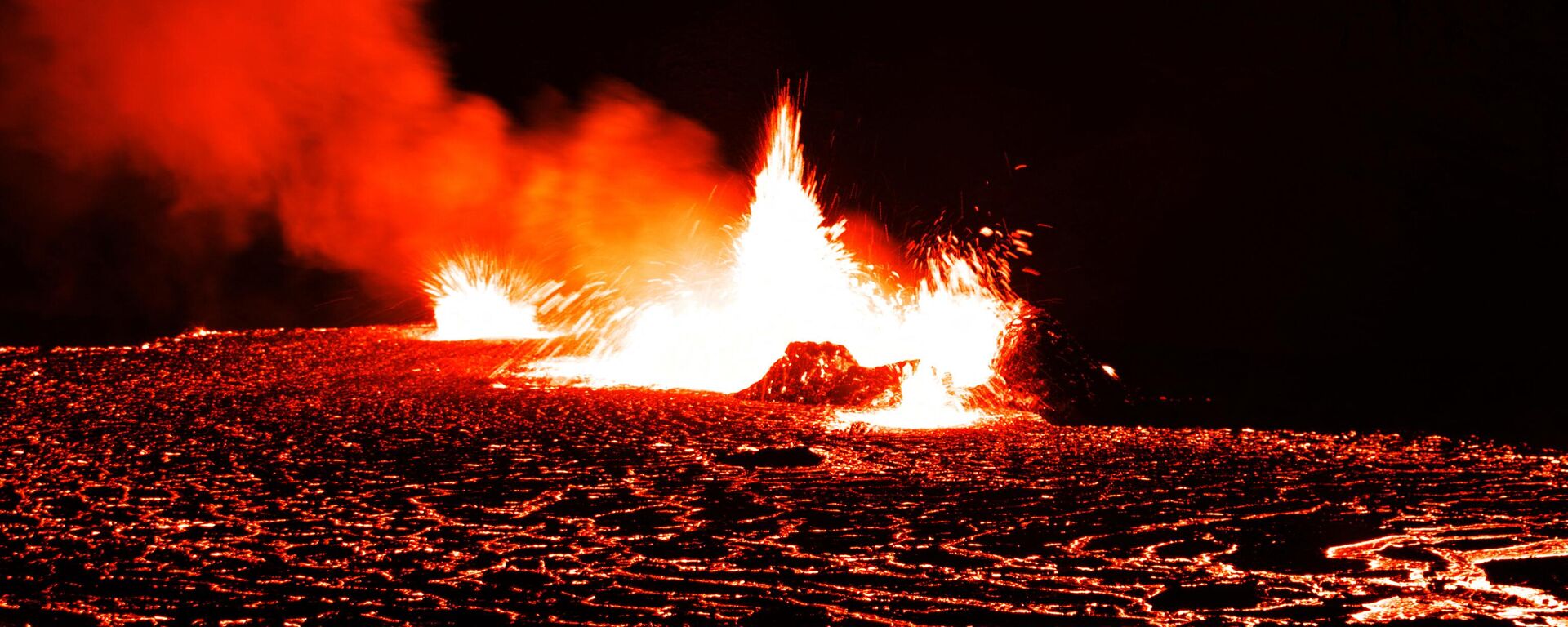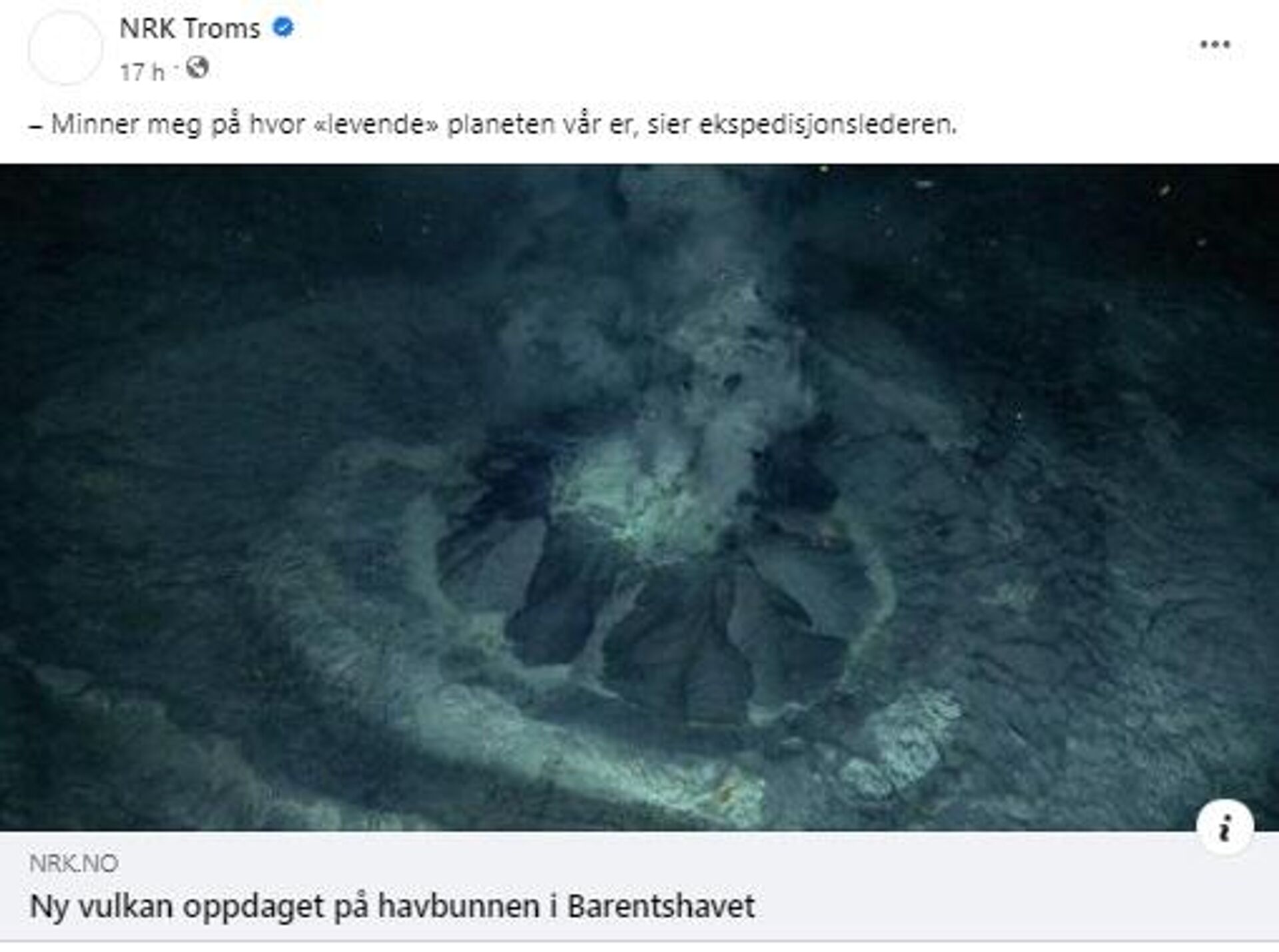https://sputnikglobe.com/20230510/norway-discovers-breathing-mud-volcano-in-barents-sea---photo-1110231904.html
Norway Discovers 'Breathing' Mud Volcano in Barents Sea - Photo
Norway Discovers 'Breathing' Mud Volcano in Barents Sea - Photo
Sputnik International
The find discovered using seismic data and remote footage is expected to provide researchers with clues to the Earth's past and knowledge about the methane budget.
2023-05-10T07:10+0000
2023-05-10T07:10+0000
2023-05-10T07:10+0000
beyond politics
europe
barents sea
earth
arctic
norway
scandinavia
science & tech
https://cdn1.img.sputnikglobe.com/img/107682/30/1076823058_0:0:3162:1779_1920x0_80_0_0_2163c989f5a7492fd6d8bc7e74933a15.jpg
A subsea mud volcano near the Norwegian island of Bjornoya in the Barents Sea has been found by researchers at the Arctic University.The find, dubbed the Borealis Mud Volcano, is located at a depth of 400 meters, some 80 nautical miles south of Bjornoya. It is only the second active volcano ever to be found in Norwegian waters.The volcanic area is approximately 300 meters wide and 25 meters deep, and releases mud, liquids and gas from the Earth's interior. The volcano itself is seven meters in diameter and 2.5 meters high, and continuously emits methane-rich liquids.The volcano was discovered rather unexpectedly using seismic data and footage obtained with a remotely operated underwater robot.She described seeing an underwater mud eruption as a reminder of how "alive" the planet is.According to the researchers, the find will provide science with new knowledge of the planet and provide a clue to the Earth's past environments. Among others, the discovery will help scientists understand the effect of localized but persistent emissions of methane and their impact on ecosystems, Panieri explained further."Understanding the evolution and composition of the fluids helps us understand their potential impact on the global methane budget and can inform what is happening on other planets. The crater in the newly discovered volcano hosts a rich seabed life, which thrives on the steep flanks of the carbonate crusts that were formed several thousand years ago," professor Stefan Buenz of the research team said in a press release.Panieri couldn't rule out that more volcanoes will be discovered in the Barents Sea using advanced technology and cross-discipline cooperation between various institutions.
https://sputnikglobe.com/20221231/scientist-warns-of-fallout-from-erupting-volcanoes-that-woke-up-in-2022-1105956897.html
barents sea
earth
arctic
norway
scandinavia
Sputnik International
feedback@sputniknews.com
+74956456601
MIA „Rossiya Segodnya“
2023
News
en_EN
Sputnik International
feedback@sputniknews.com
+74956456601
MIA „Rossiya Segodnya“
Sputnik International
feedback@sputniknews.com
+74956456601
MIA „Rossiya Segodnya“
subsea mud volcano, methane budget, active volcano, methane emissions, underwater volcano
subsea mud volcano, methane budget, active volcano, methane emissions, underwater volcano
Norway Discovers 'Breathing' Mud Volcano in Barents Sea - Photo
The find was discovered in an unexpected way, using seismic data and footage obtained with a remotely operated underwater robot, and is expected to provide researchers with clues to the Earth's past environments and knowledge about the methane budget.
A subsea mud volcano near the Norwegian island of Bjornoya in the Barents Sea has been found by researchers at the Arctic University.
The find, dubbed the Borealis Mud Volcano, is located at a depth of 400 meters, some 80 nautical miles south of Bjornoya. It is only the second active volcano ever to be found in Norwegian waters.
The volcanic area is approximately 300 meters wide and 25 meters deep, and releases mud, liquids and gas from the Earth's interior. The volcano itself is seven meters in diameter and 2.5 meters high, and continuously emits methane-rich liquids.
The volcano was discovered rather unexpectedly using seismic data and footage obtained with a remotely operated underwater robot.
"We showed that there was a formation in this area, because we could see the crater. But we didn't think we would find a volcano. It was very unexpected. No one has been there before either, so it is the first time anyone has seen this volcano. We could see that our earth was 'breathing' through this volcano. It was very surreal and very great for our team. We are all super-enthusiastic about the discovery," Arctic University professor and expedition leader Giuliana Panieri told Norwegian media.
She described seeing an underwater mud eruption as a reminder of how "alive" the planet is.

31 December 2022, 14:40 GMT
According to the researchers, the find will provide science with new knowledge of the planet and provide a clue to the Earth's past environments. Among others, the discovery will help scientists understand the effect of localized but persistent emissions of methane and their impact on ecosystems, Panieri explained further.
"Understanding the evolution and composition of the fluids helps us understand their potential impact on the global methane budget and can inform what is happening on other planets. The crater in the newly discovered volcano hosts a rich seabed life, which thrives on the steep flanks of the carbonate crusts that were formed several thousand years ago," professor Stefan Buenz of the research team said in a press release.
Panieri couldn't rule out that more volcanoes will be discovered in the Barents Sea using advanced technology and cross-discipline cooperation between various institutions.
A mud volcano or mud dome is a landform created by the eruption of mud or slurries, water and gases. The output of a mud volcano is mostly formed as hot water, heated deep below the Earth's surface and mixed and blended with subterranean mineral deposits, thus creating the mud slurry exudate. Among others, dozens of mud volcanoes are found on the Taman and Kerch Peninsulas in Russia. Possible mud volcanoes have been identified even on Mars.






